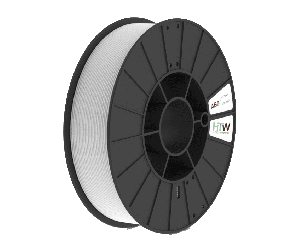ABS filament

The most popular filament in a 3D printing world is a filament made from ABS plastic (ABS — Acrylonitrile Butadiene Styrene). This is nontransparent plastic - impact resistant thermoplastic polymer. The extrusion temperature of ABS filament is from 210 °C to 270 °C. Printed goods from ABS material can be used at a temperature up to 90 °C, durable and at the same time they are flexible enough.
ABS plastic is easy to process. Parts, printed from ABS filament, can be glued and dyed with ease, can be dissolved in acetone. ABS plastic is not dangerous or harmful under normal conditions. But the ready goods, printed from ABS filamen, are not used for food purposes (except cold food) and should not contact to any alcohol-containing liquids.
ABS plastic is an impact resistant material, which is qualified as an engineering plastic. It offers high resistance to impact loads as compared to a general-purpose polystyrene, high-impact polystyrene and other styrene copolymer. ABS plastic exceeds these materials by mechanical strength grade and stiffness. ABS material is wearproof, can stand short-duration heating up to 90-100 °C. The maximum temperature of continuous exploitation is 75-80 °C. It is alkali-proof, resistant to lubricating oils, inorganic salts and acids salines, hydrocarbons, fats, benzine. The plastic is soluble in acetone, ester, benzole, ethylchloride, ethylene chloride, aniline, anisole. Filament and printed goods from ABS plastic are not resistant to ultraviolet emission.
Physical and mechanical properties of the ABS filament:
- Dencity: 1.02-1.08 g/cm3
- Tensile strength: 35-50 MPa
- Bending resistance: 50-87 MPa
- Compression resistance: 46-80 MPa
- Stretch ratio: 10-25 %
- Shrinkage (during printing process): 0.4-0.7 %
- Moisture absorption: 0.2-0.4 %
- Modulus of elasticity in tension at 23 °C: 1700 - 2930 MPa
- Charpy impact strength (with notch): 10-30 kJ/m2
- Brinnel hardness: 90-150 MPa
- Martens temperature: 86-96 °C
- Softening temperature: 90-105 °C
- Maximum temperature of continuous exploitation: 75-80 °C
- Process temperature range: 200-260 °C
- Dielectric capacity at 106Hz: 2.4-5.0
- Dielectric loss factor at 106 Hz: (3-7)·10-4
- Volume resistivity: 5x1013 Ohm/m
- Dielectric strength: 12-15 MV/m
- Self-ignition temperature: 395 °C
Filament colors: